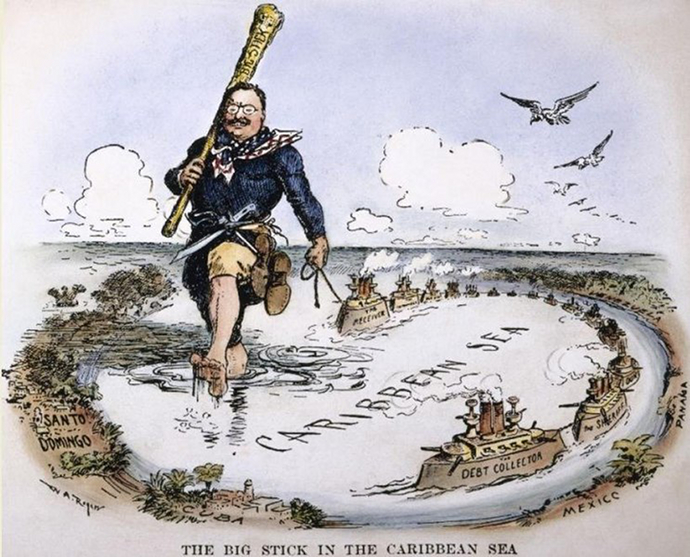Teddy Roosevelt and his big stick. 1904 cartoon by William Allen Rogers.
Latin America and the USA: chains of debt
by Marco A. Gandásegui hijo
Like a wounded beast, the US government is hitting out in all directions. Simultaneously, it launches its attacks against China and Iran. The fury is also directed at their allies. The Latin American countries are those that have suffered the most from the bravado of the wounded beast. Cuba has been blockaded by the United State for 60 years. Venezuela has just become the object of an ’embargo’ (blockade) that aims to suffocate the Bolivarians. But the other Latin American countries are also under attack.
The most-used US weapon is the economic one. The first country to fall under the clutches of US banks was Haiti, more than 200 years ago. When the Caribbean country became independent from France, it sought help in Washington but the slave-owning governments turned their backs on it. The ex-colony that exported sugar was blocked and subjected to an embargo by France and the United States. From being the richest country in the Americas at the dawn of the industrial revolution, Haiti became, to this day, one of the poorest countries in the world.
The same thing happened to Argentina. From the most prosperous country at the beginning of the 20th century, today it has become the most indebted. The stores are empty and Argentine families go hungry in a country that recently fed the world. Loans from the International Monetary Fund (IMF) are sinking it deeper and deeper every day.
The Andean countries are in a crisis that seems to have no solution. Chile only exports copper and is dependent on international prices. Its health, education and social security systems have gone bankrupt, farmers see no future and the indigenous (Mapuche) population is repressed in order to dispossess them of their lands.
Peru is the richest country in minerals in the region, but corruption has put its latest presidents in jail. The current president wants to move the elections forward to get out quickly of what he feels is a trap. Moreover, he has to deal with the Lima Group created by the United States to conspire against the Bolivarian government of Venezuela.
Ecuador became lost in the US-generated labyrinth that is also turning the Galapagos Islands into a military base. Colombia is the saddest case in Latin America. Invaded by the United States, forced into debt to buy billions of dollars in combat weapons and organized to produce cocaine for the US market.
The largest country – Brazil – is going through a moment of uncertainty with a corrupt government that depends on the support of the exporting land-owing oligarchy, the US Embassy and a nationalist military caste. It is an explosive combination that represses the urban poor, peasants and indigenous peoples.
The exceptions in this gloomy picture of South America are Bolivia and Uruguay. Bolivia has a national development plan that exploits its natural resources and invests in the education and health of its population. Uruguay has a democracy that the United States wants to destroy – without success – in order to submit it to its policies of indebtedness.
Mexico and Central America have been the object of experiments of all kinds by US corporations. The US-Mexico Trade Agreement (NAFTA) destroyed the Aztec country’s agriculture and forced the most impoverished sectors to migrate to the northern country where they are exploited by large agricultural estates for wretched wages. Having exhausted the Mexican labor force (mostly of indigenous extraction), it is now uprooting Central Americans from their countries of the so-called Northern Triangle. Meanwhile, it has destroyed the political and social institutions of Guatemala, El Salvador and Honduras. The United States accuses Mexico and Nicaragua, which are resisting the White House offensive, of being potentially dangerous countries for US national security.
Puerto Rico, a US colonial aberration, subject to a Management Board, should take advantage of this political juncture to negotiate its independence. Panama has been trying to negotiate a trade agreement with China since 2017, but Washington positioned itself in front of the Canal with a gunboat. Panama’s negotiating capacity is being tested.
Relations between the United States and Latin America are explosive. Everything indicates that the crisis of hegemony that the United States is going through does not allow it to maneuver to change course. It will be up to the countries of the region to break the chains that subject them to the policies of indebtedness.
Contact us by email at fund4thepanamanews@gmail.com
These links are interactive — click on the boxes













